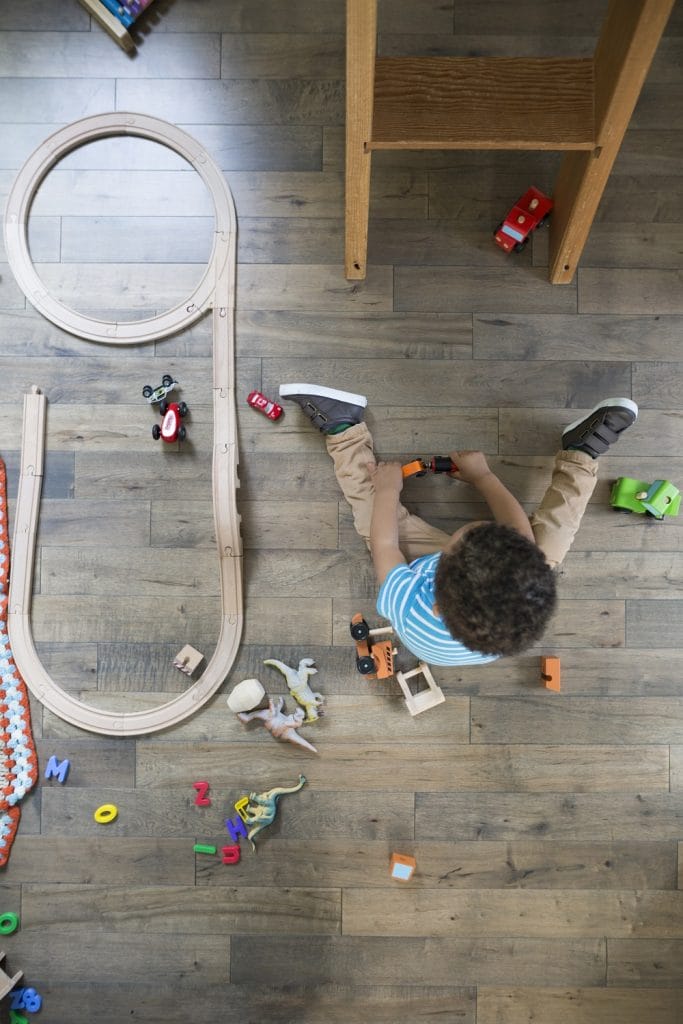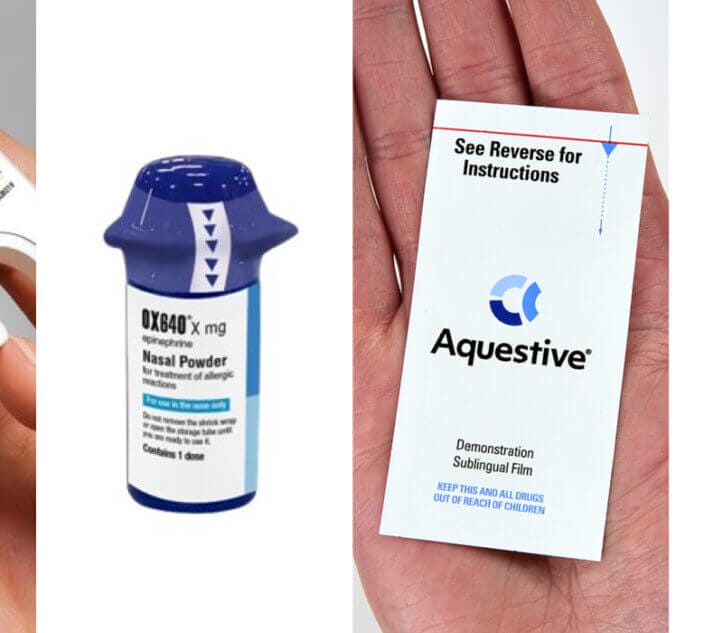 Solid hardwood is durable, stunning, keeps allergens at bay and doesn't emit VOCs. Engineered wood is cheaper, but you will need to look for brands that don't off-gas. Photo: Getty
Solid hardwood is durable, stunning, keeps allergens at bay and doesn't emit VOCs. Engineered wood is cheaper, but you will need to look for brands that don't off-gas. Photo: Getty From hardwood to ‘friendly’ engineered planks, stone, cork and even retro linoleum, our Healthy Home columnist explores the healthiest flooring choices.
ASK most allergists and they’ll tell you: for people with allergies and asthma, carpeting can be bad news. It harbors dust, pollen and other allergens; it provides a perfect environment for mold and dust mites to grow; it’s difficult to clean; and many synthetic carpets emit volatile organic compounds, or VOCs, which can trigger asthma and irritate the eyes, nose and throat.
Fortunately, from hardwood to cork to stone tile, there are myriad healthy flooring options today. The key is deciding which ones suit your look, your lifestyle and your budget.
So whether you’re pulling up that old shag, you’ve sanded that hardwood one too many times, or you’re finally losing the worn-out laminate, what to put underfoot?
Hard Flooring Options
In general, hard surface flooring is the best bet for those with allergies and asthma, because it’s easy to sweep and mop, and it doesn’t attract dust mites or mold – but the floors aren’t all created equal.
Portland-based architect and bestselling author Eric Corey Freed says most people choose flooring based on look, but there are many other factors they should consider. Want an especially quiet space? Check out cork, which provides great natural sound insulation, instead of ceramic tile, which reflects sound. (Wood is somewhere in the middle.)
Will people be walking barefoot? Try wood, cork or ceramic tile with radiant heat that’s cozier on the toes. Is this for a moisture-prone area, such as a basement or bathroom? Skip the hardwood and go for polished concrete, tile or linoleum.
A key concern that many forget is how the floor will be installed. “If you already have a finished floor such as hardwood, you can’t tile on top of it with a thick tile because none of your doors will swing open. All of your baseboard molding will have to be removed and reinstalled, or it will look weird,” cautions Freed, founder of the green design firm organicARCHITECT. “A lot of people don’t think about this until after they’ve ordered the tile, and then it’s too late.”
Aesthetics are important, but Freed warns clients away from only trusting their taste, and forgetting what else is going on in the room. He gives this example: “You see this gorgeous dark walnut wood floor, and it’s being reclaimed from an old bridge, so it’s got this great history, and it’s beautiful and you love it. But all your furniture is dark brown leather – so you’re putting dark brown furniture on a dark brown floor, and suddenly everything disappears.”
The owners will know the room looks odd, but may not quite see the issue “until an architect or interior designer friend comes over and says, ‘Yeah, you’ve got to get all new furniture,” says Freed. “So I often like selecting deliberately contrasting flooring.”
When you’re looking at samples, he adds, remember that our eyes are usually 5 feet from the floor, so the flooring will look very different installed than it does on close inspection. “You want to think in terms of texture, acoustics, coziness, warmth and color, because all of these factors play into composing the room.”
A World of Wood
 Expert Eric Corey Freed: 'People confuse vinyl and linoleum, but they're not at all the same.'
Expert Eric Corey Freed: 'People confuse vinyl and linoleum, but they're not at all the same.' For generations, wood has been the flooring of choice across most of North America. It’s no wonder: wood is natural, durable and, even with a little wear and tear, it looks great. But with the popularity of laminate and engineered hardwood, choosing a wood floor isn’t as straightforward as it once was.
Solid wood is typically the priciest option – but also the healthiest and longest lasting. “The pros are that it’s real wood all the way through. The cons are that it’s real wood all the way through,” jokes Freed. “Wood is a living material that reacts to humidity and moisture, so over time it could buckle and creak a little. But the beauty is that it’s a 100-year floor. So you can finish it, seal it, refinish it – and it’s an all-natural product.”
Engineered wood is made from layers of wood or high-density particle board bonded together with adhesives using heat and pressure, then topped with a thin veneer of wood. The upside is that it’s less prone to expansion and contraction, and it can also be laid directly onto concrete floors, like those found in condominiums or basements. Most engineered wood can be sanded two or three times. However, some cannot be refinished at all.
Laminate flooring is made from particle board and topped with a photograph of wood to give it a real wood look – without the real wood price. The trouble with both engineered wood and laminate is that many manufacturers use formaldehyde – a common asthma trigger – as the binder, so it’s essential to find the brands that don’t use the ubiquitous adhesive. And even solid hardwood can come coated with VOC-laden lacquers.
Rather than relying on information from salespeople, Freed says consumers should always ask for the product’s Material Safety Data Sheet, or MSDS, to get the real story of what is – and isn’t – in the product, or look for reliable third-party certifications.
“You have to be really careful,” says Freed. He prefers solid wood, but also uses healthier brands of engineered wood as well as engineered bamboo planks, which are tough and made from a readily renewable resource. “All wood products have a little bit of formaldehyde naturally; that’s just chemistry. But you want to look for products that have no added formaldehyde, especially urea formaldehyde. It’s a huge environmental trigger.”
Talking Tile Flooring
Another great option is ceramic tile, which is also made from natural, renewable materials. Tile is simple to install, easy to clean, moisture-proof and comes in an endless array of colors, patterns, sizes and styles. For high-traffic areas, it’s also one of the toughest.
“It’s bulletproof. You can spill anything on it and clean it right up,” says Freed. What’s more, you don’t have to break the bank – and you can even mix and match pricier tiles with budget ones to get a higher end look. “The great thing about tile is that it’s modular,” he says. “You can have a patch of the good stuff in one area of the room and a field of much cheaper $2 a square foot tile for the rest, so there’s lots of fun you can have with it.”
The downside is that tile can be chilly underfoot, so people in shoes-off households might want to install radiant heating, which can be a surprisingly inexpensive luxury. Area rugs and wall treatments can also be used to warm up tile’s harder sound. In bathrooms, it’s important to consider the slip risk, and either install tile that has texture, or use smaller tiles so the grout lines provide grip.
Like tile, natural stone is another remarkably durable product that comes in a variety of sizes, thicknesses and styles, is easy to clean and doesn’t off-gas. Especially when used as flooring, it offers a more opulent look – and tends to come with a heftier price tag. But before you install marble in your entrance way or slate in that spa bath, check that your home’s structure can support the additional weight; then seal the stone with a safe finish.
“Sandstone is very soft and porous and absorbent, so it has to be sealed; otherwise the first time someone spills wine you’re going to be very unhappy,” says Freed. “Slate is super resistant to stains – but it does scratch if you’re not careful. So you pick what issue you want to deal with.”
As with all flooring, he adds, just make sure that all sealants are zero-VOC; the architect’s go-to choice is AFM Safecoat.
Resilient Flooring Differences
 Cork is dust-proof, mold-proof and waterproof. Plus, it's a great sound absorber. Photo: APCOR cork association.
Cork is dust-proof, mold-proof and waterproof. Plus, it's a great sound absorber. Photo: APCOR cork association. One of the most popular areas of the flooring market these days is “resilient flooring” – a category that includes softer options such as linoleum and cork as well as vinyl (also known as polyvinyl chloride or PVC). Freed strongly advises clients to skip the vinyl, which is a petroleum product that will off-gas, and instead opt for natural linoleum – which offers most of the same benefits, but not the health-related drawbacks.
“People confuse vinyl and linoleum, but they’re not at all the same,” says Freed. “Linoleum is a natural product made from linseed oil and sawdust. It’s your grandmother’s floor, and comes in tiles, planks and solid sheets.” It’s naturally antistatic and anti-dust, he adds, so “it’s great for people with allergies.”
The only real downside is linoleum’s reputation as a relic from the past. “I love linoleum, but some people find it looks dated, so we tend to go with the solid, bright colors to offset that. Anything in beiges and tans reminds everyone of being in school.”
Another favorite of Freed’s is cork, a natural product that’s waterproof, dust- and mold-resistant, warm and soft underfoot and a wonderful sound absorber. It’s softer, so it can get scratched or gouged, but overall, it lives up to its resilient name.
“When most people think cork, they think corkboard, but people have probably been on a cork floor and not even realized it, because they come in all different patterns and shades. Acoustically it’s amazing, and it’s great for a kitchen because you can have spills,” says Freed, whose go-to companies include Jelinek. “It’s just very pretty. And cork also has this great hickory smell to it, which I really enjoy.”
With Allergies, Keep It Simple
Still not sure which floor to lay down? Especially for homes where people have allergies and sensitivities, Building Green executive editor Tristan Roberts offers one key piece of advice: keep it simple. The website is often called the Consumer Reports of eco-friendly building materials. While Roberts prefers not to name particular brands, he believes it’s best to use natural materials in their most basic form. Plus, use the fewest finishes and adhesives.
 BuildingGreen.com's Tristan Roberts: prefers solid hardwood.
BuildingGreen.com's Tristan Roberts: prefers solid hardwood. “My go-to would be solid hardwood flooring because you know exactly what you’re getting and it’s easy to install without adhesives,” says Roberts. He emphasizes that flooring is an especially important decision, because it covers so much of a home’s surface area and homeowners are in regular contact with it. He also likes tile – as long as it’s made from natural materials and not plastic composites – and concrete floors that you polish to a lovely finish.
Roberts agrees that consumers shouldn’t rely on what salespeople tell them, and recommends looking specifically for FloorScore and GreenGuard Gold certifications, which indicate tough environmental and health standards have been met.
“Unless you’re buying specifically from a small provider and you know exactly what you’re getting, it’s critical to get certified products,” he says. “There are quality engineered products, but you want verification that they don’t have toxic chemicals. Personally I would err on the side of a solid product.”
Overall, the flooring industry has significantly evolved in recent years, bending to consumers’ demands for better product labeling and fewer toxic adhesives and finishes. Freed encourages people to continue speaking up, and to talk openly with their contractors, designers, architects and retailers, stressing that they want only healthy products in their homes.
“For too long there’s been the assumption that because there are building codes, the products are healthy. Building codes don’t guarantee the environmental health of a material. They are there to protect your safety and welfare if there is tire or an earthquake. But except for lead paint and asbestos, you can build with just about anything – and that’s the problem. So talking very openly with your contractor will not only educate him or her; it will also be a chance to start having a dialogue,” he says. “That’s how we create positive change.”
Read more Healthy Home articles:
Four Healthy Homes Where Superb Design Also Offers Better Breathing
Creating the Better Baby Nursery: Out With Allergens and VOCs
TV Reno Expert’s Advice: How to Keep Water, Mold and Pests Out of Your Home





